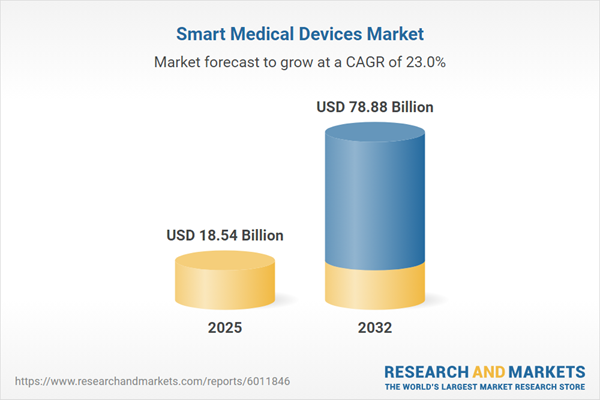Speak directly to the analyst to clarify any post sales queries you may have.
The smart medical devices market is reshaping healthcare through digital integration, allowing organizations to improve patient outcomes and operational agility. Leaders who navigate these changes effectively can strengthen their competitive positioning and foster sustainable growth in a rapidly evolving sector.
Market Snapshot: Smart Medical Devices Market
The smart medical devices market is experiencing substantial growth, driven by increasing adoption of connected health solutions and expanded industry investment. In 2024, the market size reached USD 15.07 billion, with expected growth to USD 18.54 billion by 2025 and USD 78.88 billion by 2032. This expansion reflects a compound annual growth rate of 22.98%. Market momentum continues due to advancing analytics capabilities, deeper digital integration within healthcare systems, and efforts to enhance workflow efficiency. As organizations respond to these trends, smart medical devices help elevate global responsiveness and support the continuing evolution of care delivery.
Scope & Segmentation: Strategic Opportunities
This report enables senior decision-makers to identify high-impact investment areas supporting digital transformation and operational efficiency within the smart medical devices landscape. Explored segmentation provides a comprehensive perspective across technology, applications, end users, and regions, empowering targeted strategies for sustainable competitive advantage.
- Device Types: Encompasses portable diagnostic solutions including handheld ultrasound and ECG systems, stationary patient monitoring equipment, digital inhalers, pain management platforms, and wearables such as smartwatches and biosensors, allowing for individualized monitoring and streamlined diagnostics.
- End Users: Hospitals, clinics, ambulatory care centers, and home care providers are integrating smart devices to modernize workflows, improve responsiveness, and elevate the patient experience across diverse care environments.
- Technologies: Incorporates enterprise-grade wearables, implantable devices, and both minimally and non-invasive systems to increase data precision, patient safety, and adaptability across a broad range of clinical scenarios.
- Applications: Facilitates advances in specialist fields including cardiology, diabetes management, neurology, orthopedics, and oncology, supporting outcome improvement and operational agility in these critical areas.
- Regions Covered: Includes in-depth analysis of the Americas, Europe, Asia-Pacific, and Middle East & Africa, assessing regional regulatory differences, digital adoption rates, and local market entry requirements to inform effective international strategies.
- Key Companies Profiled: Reviews business strategies from leading organizations such as Medtronic plc, Abbott Laboratories, Siemens Healthineers AG, GE HealthCare Technologies Inc., Koninklijke Philips N.V., Johnson & Johnson, Becton, Dickinson and Company, Stryker Corporation, Boston Scientific Corporation, and Dexcom, Inc., highlighting their approaches to innovation and industry collaboration.
Key Takeaways for Senior Leaders
- Collaboration between healthcare and technology providers is expediting the deployment of integrated, secure medical device platforms while ensuring regulatory processes for data exchange remain aligned and transparent.
- Advanced analytics, artificial intelligence, and machine learning within smart devices are enhancing diagnostic accuracy and enabling senior teams to adopt predictive planning for resource optimization.
- Commitment to interoperability and improved connectivity is removing data silos and supporting seamless care coordination, leading to more informed clinical and operational decision-making.
- Wearable and mobile device innovations are producing actionable data that empower care teams, facilitating tailored interventions and greater patient engagement across the continuum of care.
- Agile approaches to supply chain management are maintaining consistent equipment availability and compliance, even as local regulations and global logistics requirements evolve.
- Strategic alliances, mergers, and technology partnerships are opening access to novel technologies and extending organizational market reach, encouraging the adoption of new solutions and accelerating transformation efforts.
Tariff Impact and Global Trade Dynamics
Recent changes in United States tariffs have prompted healthcare organizations to reassess manufacturing and logistics models for smart medical devices. Emphasis on regional partnerships and localized production is strengthening supply chain resilience, ensuring regulatory alignment, and safeguarding device availability for healthcare providers adapting to these shifts.
Methodology & Data Sources
This report is developed from secondary market research combined with direct interviews involving device manufacturers, healthcare practitioners, regulatory specialists, and logistics professionals. All evidence is cross-referenced to ensure accuracy and compliance with industry benchmarks.
Why This Report Matters for Executives
- Enables implementation of advanced medical solutions within resilient, regulatory-compliant operational frameworks that support safe and effective care delivery.
- Delivers actionable guidance on supply chain optimization and regulatory planning, facilitating scalability and future-proofing organizational operations.
- Supports strategic technology adoption and digital transformation to drive measurable improvements in both clinical and business performance.
Conclusion
Strategic investment in digital capabilities and operational alignment prepares organizations to realize value from the growing smart medical devices market, supporting improved healthcare delivery and sustained organizational advancement.
Additional Product Information:
- Purchase of this report includes 1 year online access with quarterly updates.
- This report can be updated on request. Please contact our Customer Experience team using the Ask a Question widget on our website.
Table of Contents
3. Executive Summary
4. Market Overview
7. Cumulative Impact of Artificial Intelligence 2025
Companies Mentioned
The companies profiled in this Smart Medical Devices market report include:- Medtronic plc
- Abbott Laboratories
- Siemens Healthineers AG
- GE HealthCare Technologies Inc.
- Koninklijke Philips N.V.
- Johnson & Johnson
- Becton, Dickinson and Company
- Stryker Corporation
- Boston Scientific Corporation
- Dexcom, Inc.
Table Information
| Report Attribute | Details |
|---|---|
| No. of Pages | 180 |
| Published | October 2025 |
| Forecast Period | 2025 - 2032 |
| Estimated Market Value ( USD | $ 18.54 Billion |
| Forecasted Market Value ( USD | $ 78.88 Billion |
| Compound Annual Growth Rate | 22.9% |
| Regions Covered | Global |
| No. of Companies Mentioned | 11 |









